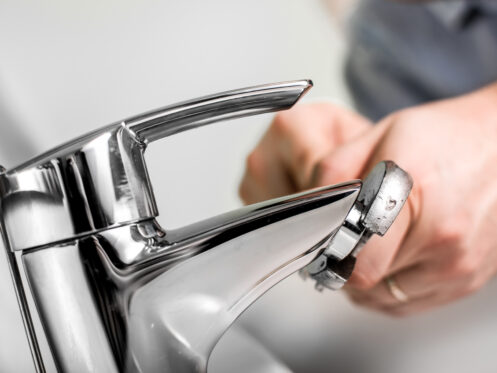A slow, steady faucet leak is often more than just the result of a worn washer. This leak can indicate water pressure issues, valve damage, or even hidden plumbing problems behind your walls. At Pacific Plumbing & Rooter Inc in Eugene, OR we’ve helped plenty of homeowners figure out why their faucet is leaking and what to do next. It’s time to fix the problem once and for all.
1. Worn-Out Washers Allowing Water Flow
One of the most common causes of a dripping faucet is a washer that’s past its useful life. Inside most faucets, a small rubber washer sits between the valve seat and the spout. Every time you turn the handle, that washer presses down to stop the flow of water. If the washer becomes too stiff, starts to crack, or no longer fits snugly, water can sneak past it. You might not see any damage on the outside, but the faucet is still leaking. Over years of twisting the handle, even small misalignments wear the washer unevenly. Once that seal breaks, it can’t hold the pressure the same way. The drip might start slow, but it usually gets worse. Replacing the washer doesn’t take long, but figuring out the right size and shape can be tricky if the faucet is older. That’s where most people get frustrated. You think you’ve fixed it, but the leak comes back because the part wasn’t a perfect fit.
2. Loose or Damaged Valve Seats
The valve seat connects the faucet to the spout. If you picture water flowing through a narrow tunnel, the valve seat is the point where that tunnel narrows to control the stream. This part of the faucet faces a lot of pressure, especially in areas with hard water. Minerals start to collect along the valve seat. Over time, that buildup eats away at the metal. A once-smooth surface becomes rough or pitted, and water starts to sneak through even when the faucet is off. In some cases, the seat itself gets loose, which throws off the whole alignment. If it’s too far gone, the faucet might need replacing.
3. High Water Pressure Wears Down Your Fixtures
If your faucet leaks at certain times of the day or only after running another tap or appliance, the problem could be water pressure. When pressure inside your plumbing system gets too high, it tries to escape wherever it can. Faucets become one of the first places where stress shows up. You might see water weeping out of the spout even though the handle is tightly shut. That’s because the parts inside the faucet weren’t built to hold back that kind of force long-term. High pressure doesn’t just cause leaks. It can damage seals and washers faster than normal use would. Most homes should sit between 40 and 60 psi. Anything higher can start to cause problems. A pressure-reducing valve can help regulate the problem, but a plumber needs to confirm what’s going on first.
4. Old Cartridges Stop Holding a Seal
Cartridge faucets feature a single, removable unit that controls both temperature and flow. These designs are usually more reliable than older types, but they’re not immune to problems. Inside the cartridge are several rubber or silicone seals. When those seals get worn, cracked, or misaligned, they stop holding pressure. Water seeps past the cartridge and escapes out the spout, even when the handle is off. Replacing the cartridge usually fixes the leak, but only if the new part matches the faucet perfectly. With so many different styles on the market, people often end up guessing or grabbing the wrong part from a hardware store. You might get the faucet open, swap in the new cartridge, and still see a drip.
5. Corrosion Changes the Shape of Internal Parts
Metal doesn’t last forever inside a plumbing system. Water, temperature changes, and cleaning chemicals all chip away at the smooth finish of internal faucet parts. Once corrosion starts, it changes the way those parts fit together. What used to be a watertight seal is now home to tiny gaps. In some faucets, that corrosion happens where you can’t access it without taking everything apart. Threads wear down. O-rings get pinched or settle unevenly. You tighten the handle, but water still leaks out. In extreme cases, corrosion breaks a part completely and floods the base of the faucet. If you’ve already replaced washers and cartridges without luck, corrosion might be hiding in the housing or valve body.
6. O-Rings Dry Out or Slip Out of Place
An O-ring is a small, round piece of rubber that helps seal the connection between different parts of a faucet. In most modern designs, you’ll find one around the base of the spout or inside the handle. These rings sit in grooves, pressed tight to stop leaks. As the rubber ages, it can crack or shrink. A faucet that starts dripping from the handle instead of the spout often points to a worn O-ring. In some cases, the O-ring just slips out of place after too many twists and turns. Once that happens, water flows where it shouldn’t. If the new ring isn’t sized right or doesn’t tightly seal, you’ll see water leaking again.
7. Hard Water Leaves Behind Mineral Buildup
If your home has hard water, mineral deposits can form inside your faucet faster than you think. Calcium and magnesium settle into every crevice, especially at points where water collects. That buildup isn’t just unsightly. It changes how water moves through the faucet. Moving parts can get stuck. Washers don’t sit flat. Cartridges can jam or crack under the added pressure. When minerals coat the valve seat, they create an uneven surface that leaks even if your seals are in good shape. You might notice white or green crust around the spout or handle. That’s usually a sign that the inside doesn’t look much better. Cleaning the faucet with vinegar or a descaling solution can help, but only if the buildup isn’t too advanced. Once the mineral scale changes the shape of the parts inside, replacement becomes the only fix.
8. Improper Installation Can Set You Up for Leaks
Even a brand-new faucet can drip if something isn’t put together right. A misaligned washer or loosely fitted cartridge can cause leaks right from the start. Some people install new faucets themselves but forget to use plumber’s grease, tighten connections properly, or match parts to the fixture’s design.
Those small mistakes don’t always show up right away. You might get weeks of clean performance before a slow drip starts. Installation errors also happen when parts from different brands get swapped in. Not all cartridges or washers are universal, even if they look similar.
9. Handles That Don’t Turn Cleanly Can Cause Issues
If your faucet handle feels stiff or gritty when you turn it, that friction could be a warning sign. A rough turn means something inside isn’t sliding the way it should. That could be mineral buildup, worn threads, or a part starting to deform. As the internal components grind against each other, they shift slightly. Eventually, the seals inside lose contact with the valve seat or spout. That movement opens the door for a leak to form.
Solve Your Leaking Faucet Trouble Today
Ignoring a faucet that drips nonstop doesn’t just waste water. It can signal bigger problems in your plumbing system. When you catch these issues early, repairs tend to be smaller, quicker, and cheaper. We also offer pipe replacement, water pressure diagnostics, and fixture upgrades. If something about your plumbing system requires professional attention, call Pacific Plumbing & Rooter Inc for assistance in Eugene.







